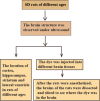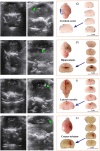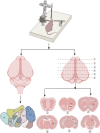Ultrasound-guided puncture into newborn rat brain
- PMID: 38680504
- PMCID: PMC11045190
- DOI: 10.1002/ibra.12103
Ultrasound-guided puncture into newborn rat brain
Abstract
Since the brain structure of neonatal rats was not fully formed during the first 4 days, it cannot be detected using ultrasound. The objective of this study was to investigate the use of ultrasound to guide puncture in the normal coronal brain structure and determine the puncture depth of the location of the cortex, hippocampus, lateral ventricle, and striatum of newborn rats of 5-15 days. The animal was placed in a prone position. The specific positions of the cortex, hippocampus, lateral ventricle, and striatum were measured under ultrasound. Then, the rats were punctured with a stereotaxic instrument, and dye was injected. Finally, the brains of rats were taken to make frozen sections to observe the puncture results. By ultrasound, the image of the cortex, hippocampus, lateral ventricle, and striatum of the rat can be obtained and the puncture depth of the cortex (8 days: 1.02 ± 0.12, 10 days: 1.02 ± 0.08, 13 days: 1.43 ± 0.05), hippocampus (8 days: 2.63 ± 0.07, 10 days: 2.77 ± 0.14, 13 days: 2.82 ± 0.09), lateral ventricle (8 days: 2.08 ± 0.04, 10 days: 2.26 ± 0.03, 13 days: 2.40 ± 0.06), and corpus striatum (8 days: 4.57 ± 0.09, 10 days: 4.94 ± 0.31, 13 days: 5.13 ± 0.10) can be accurately measured. The rat brain structure and puncture depth changed with the age of the rats. Ultrasound technology can not only clarify the brain structure characteristics of 5-15-day-old rats but also guide the puncture and injection of the rat brain structure. The results of this study laid the foundation for the future use of ultrasound in experimental animal models of neurological diseases.
Keywords: brain structure; cortex; hippocampus; lateral ventricle; striatum; ultrasonoscopy.
© 2023 The Authors. Ibrain published by Affiliated Hospital of Zunyi Medical University and Wiley‐VCH GmbH.
Conflict of interest statement
Kun Zhang is employed by the company Shantou Ultrasonic Instrument Research Institute Co. Ltd. He confirms that he has no commercial interest that could be produced from this manuscript. The remaining authors declare that the research was conducted in the absence of any commercial or financial relationships that could be construed as a potential conflict of interest.
Figures





References
-
- Dietrich C, van Lieshout J, Fischer I, et al. Transcranial Doppler ultrasound, perfusion computerized tomography, and cerebral angiography identify different pathological entities and supplement each other in the diagnosis of delayed cerebral ischemia. Acta Neurochir Suppl. 2020;127:155‐160. 10.1007/978-3-030-04615-6_23 - DOI - PubMed
-
- Weile J, Frederiksen CA, Laursen CB, Graumann O, Sloth E, Kirkegaard H. Point‐of‐care ultrasound induced changes in management of unselected patients in the emergency department ‐ a prospective single‐blinded observational trial. Scand J Trauma Resusc Emerg Med. 2020;28(1):47. 10.1186/s13049-020-00740-x - DOI - PMC - PubMed
LinkOut - more resources
Full Text Sources
